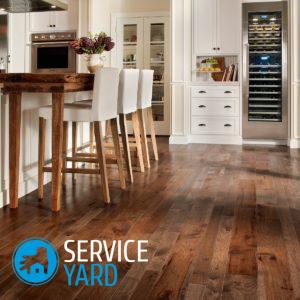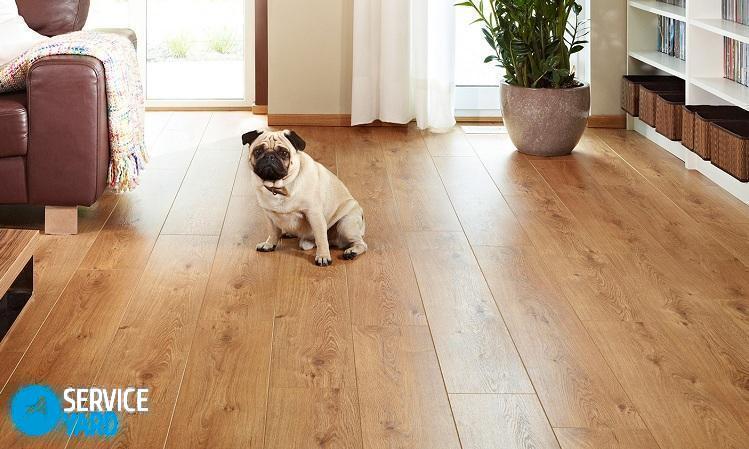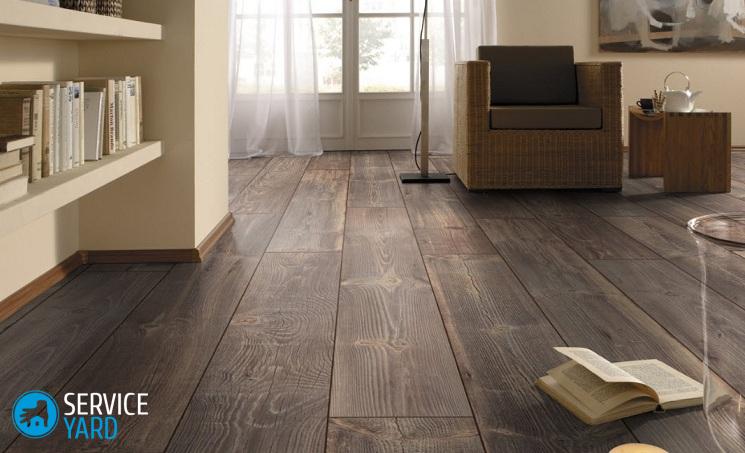Laminate sealant - which is better?

Laminate or laminated fiberboard is a common floor covering that is used both in homes and in offices. It consists of 4-5 layers, the upper of which is protective. There is a laminate for apartments, and there is a commercial view for non-residential premises with high traffic. This coating is quite practical, as it is resistant to many external influences. The only thing that does not tolerate laminate flooring, no matter how high class it is, is water. Laminate sealant - which is better? But is it needed at all and for what good purpose does it serve? In this article, we will consider this issue that interests many.
to contents ↑Do I need a sealant when laying laminate flooring?
At first glance, it seems that the laminate flooring is a single monolith, in fact, it has many joints:
- If the coating of the plates somehow protects the surface from moisture, then getting into the seams between the boards, water leads to the fact that the laminate swells and goes in waves. Manufacturers came up with such an effective protection against moisture as a sealant. It closes moisture gaps. This is a kind of elastic sealant for seams.
- In addition, the laminate can crack and creak over time, especially if it was laid poorly. Laying laminate with sealant also prevents this problem.
- Joint and gap protection extends the life of this floor covering.
- A nice bonus - high-quality sealing of all cracks increases the sound insulation of the room.
Features of sealant for laminate joints:
- The sealant is resistant to moisture and ultraviolet.
- The tool does not have an adhesive base, so it does not complicate the process of dismantling and re-laying the laminate.
- The sealant does not leave spots on the surface of the coating, as it is transparent in itself, therefore it is suitable for any color of the laminate (acrylic colored sealants are selected according to the color of the coating).
- It does not have any negative effect on the internal structure of the lamella.
- Easy to use and dries quickly.
- The sealant is environmentally friendly.
- He calmly tolerates temperatures from -20 to +40 degrees.
Types of sealant for laminate joints
Sealants can be acrylic and silicone. Available in the form of tubes and tubes (cylinders), which are used in conjunction with a construction gun.
Important! Manufacturers add various components to the composition:
- fungicides and antiseptics (protect the material from mold and fungus);
- chalk, quartz flour;
- organic extenders (to reduce the viscosity of the substance).
Silicone sealant
Silicone for laminate flooring has excellent technical characteristics:
- it is strong, elastic, durable;
- has good adhesion;
- It protects against moisture and is easy to use;
- silicone-based protection is safe for humans and does not stain the floor.
Click Guard Laminate Gel
Excellent sealant for Click Guard laminate (made in Germany):
- If the lamellas are treated with such protection, then they are not afraid of heavy loads.
- With this sealant, it is necessary to process seams and gaps in rooms with high traffic and high humidity.
- It improves the performance of a low-cost, low-wear laminate.
- Silicone dries in 10-15 minutes. The excess is removed with a beveled plastic spatula.
Important! The gel is available in a tube. The manufacturer claims that the capacity of 125 g should be enough for 8-10 square meters. m. Practice shows that usually a tube is enough for 7 sq. m.
It is necessary to use the sealant wisely and apply only to the castle crest with a continuous thin layer.
Important! Do not overdo it with the amount of the applied product, as the excess will come out when the groove clicks and you will have to wipe it. Do not forget to clean the surface from dust before applying the composition.
Sealants Rico “Protect click”, Bostik “Clic Protect” (made in France) have similar properties.
Acrylic Sealant
Acrylic is a synthetic polymer. As a rule, acrylic is a color sealant for a laminate, so it is easier to pick it up in a store right away with a coating:
- On acrylic sealant, even with prolonged use, a yellowish coating does not appear, it does not crack with time.
- It also forms a strong but elastic connection between the joints, has excellent adhesion to the material, protects the joints from moisture and dust, does not contain substances harmful to humans or animals.
- In addition, some external defects on the laminate and parquet can be masked with acrylic sealant.
Click Guard (Germany):
- German gel for laying laminate flooring is considered the best, has the highest moisture resistance among analogues.
- Suitable for laminate and parquet of any class with any type of locks.
- The release form is a tube with a long nose, which makes application very convenient.
- Apply sealant to the groove in the groove. Hardening time - about 15 minutes, excess is easily removed from the surface.
- Sealant tube consumption - 7-10 sq. m
Click Protect (Sweden):
- Waterproof sealant for laminate and parquet.
- The manufacturer claims that the tube lasts up to 15 square meters. m
- Drying time is 30 minutes.
Soudal:
- Colored gel for joints of the laminate and restoration of minor damage.
- It has no smell.
- The color scheme is small.
- A special gun is required for application.
Masterfix (Russia):
- It is used for laminate flooring, sheet piling from MDF.
- Consumption - up to 10 square meters. m, drying time - up to 30 minutes.
to contents ↑Important! Products of European brands, of course, are more expensive.
How to properly seal the joints of the laminate?
Mastic for crevices in the laminate can be applied during laying of the laminate, parquet or during restoration (for example, when the floor began to creak). Next, we consider in detail the correct sequence of actions during the procedure.
Application Algorithm:
- If during the initial installation another sealant was previously applied, then during restoration, remove it before applying a new one. It is convenient to do this with a spatula. Although you can use a special solvent. Perform actions carefully so as not to damage the locks.
Important! Before applying sealant joints should be cleaned of dust and debris.
- If you use sealant in a tube, apply even pressure to the bottom. If you took a bottle (tube), then use a construction gun - this will facilitate the extrusion of an even layer.
- Apply the sealant with a thin, but even layer on the top of the end of the longitudinal part (approximately in the thickness of the match). Immediately insert the lamella into the groove of the second lamella and snap the lock until the sealant has frozen. If you have applied the right layer of material, it should show a little to the surface.
- Apply sealant to the lobar part of the lamella. The substance fills the voids, but does not stick the panels together. When applying, try not to leave blank areas.
- Remove excess after drying (after 20-30 minutes) with a mowed plastic spatula, a rag soaked in gasoline, or just a dry cloth.
Important! The sealant instructions usually write how to remove excess material from the surface of the floor covering.
- The same sealant can and should close expansion joints, they will certainly be along the walls. Moisture can also get into them, so it’s better to protect them. Wet the edges with a damp cloth and seal the edge with masking tape.Fill all indentations with sealant and level the surface with a rubber spatula. After 30 minutes, remove the tape.
to contents ↑Important! If for some reason you were not able to remove the remnants of the product from the laminate in time, then do not be discouraged, an ordinary household solvent will cope with them.
Stock footage
Laminate sealant - is it necessary or not? After weighing the information submitted in the article, each for himself will decide on the answer to this question. It should also be noted that the use of mastic increases the laying time of a laminate or parquet, complicates the work. But as a result, your floor will not be afraid of wet cleaning or accidentally spilled water. In addition, over time, it will not begin to creak, as happens with the usual laying of the laminate.
- How to choose a vacuum cleaner taking into account the characteristics of the house and coatings?
- What to look for when choosing a water delivery
- How to quickly create comfort at home - tips for housewives
- How to choose the perfect TV - useful tips
- What to look for when choosing blinds
- What should be running shoes?
- What useful things can you buy in a hardware store
- Iphone 11 pro max review
- Than iPhone is better than Android smartphones





